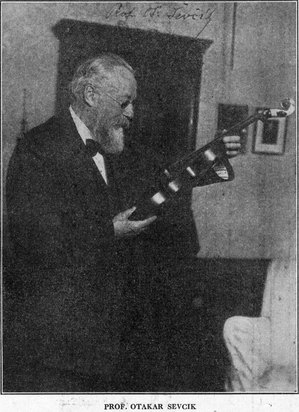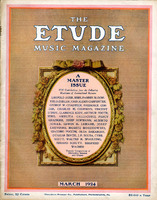The Violin Student’s Fundamentals
An Interview With the Celebrated Czecho=Slovak Master Teacher of the Violin
OTAKAR SEVCIK
Secured Expressly for THE ETUDE by Otto Meyer
(Otakar Sevcik, one of the greatest teachers of violin of all time, was born at Horazdowitz, Bohemia, March 22nd, 1852. He was a pupil of his father, A Sitt, A. Beenewitz. After successful tours and engagements as conductor in important posts, he became violin teacher in the music school of the Imperial Music Society, at Kiev. He remained in Russia for seventeen years. In 1892 he went to the Prague conservatory, where he remained for fourteen years, having among his pupils, Kubelik, Kocian, Zimbalist, Ondricek, Culbertson, Marie Hall and Otto Meyer, who collaborated in securing this article. In 1909 he became director of the Master school for Violin, in connection with the Imperial Academy of Music of Vienna. He is the author of numerous works for the violin. It is a privilege for Etude readers to have these valuable opinions of Professor Sevcik.)
 During the many years that I have taught the violin in Europe and in the United States, I have taught pupils of every age and nationality, and it has been always a matter of interest to me to compare the musical characteristics of the different nationalities.
During the many years that I have taught the violin in Europe and in the United States, I have taught pupils of every age and nationality, and it has been always a matter of interest to me to compare the musical characteristics of the different nationalities.
After the success of Kubelik, a great many American and English pupils came to study with me in Prague; and, having taught in the United States for the last several years, I have some suggestions to make to violin pupils in general, but especially to American violinists.
American pupils are as talented as any in the world, and they work as hard; but in general, they have one failing, they have not absorbed enough music into their subconscious mind. If one were to put a very fine plant in a dark cellar, and were to water and cultivate it very carefully; yet it could not grow into a fine healthy plant. So no matter how fine a musical talent we may have, and no matter how carefully the teacher may guide the musical studies, yet the lack of the light of plenty of good music in the everyday life is a great handicap. Musical education should commence in the earliest years, in the home, and should be continuous from that point on.
Musical Education in the Home
By musical education in the home, I mean that the prospective pupil should hear much singing, and many good concerts. In this way the ear is early trained; and the mind unconsciously grows accustomed to good melodies and correct harmonies. The reason that the Russian and Jewish violinists have a so uniformly good tone, and a fine vibrato, is that from the earliest years they hear much good singing in their homes and in the rituals of their religions. They learn to hear and think good tones and therefore they express good tones when they later learn the violin.
In my earlier years, I was very fortunate in being placed in a very musical atmosphere, and in having my musical sense thus developed. At five and a half years I was taught to sing; and when six and a half years old I commenced the study of the piano which was continued for a year. At seven years, I was started in my violin studies, from which time the singing and piano work were made subordinate. At the age of nine I was appointed solo alto singer in the famous Kreutzer church in Prague. This entitled constant practice in singing and reading music at sight, as I was often called upon to sing difficult arias without rehearsal. From that time on, of course, the violin studies took up the greater part of my time; but the development of the ear and sense of rhythm, which the early work in singing at sight brought about, were a most important factor in the success of my work on the violin. For this reason I now advocate strongly that young violinists shall first be able to sing their violin music. This assures that they are able to hear what they wish to play.
Another vital factor in musical success which American violin students are apt to neglect is their health. Without good health and nerves musical success is impossible; and I find that in this country the students are apt to run either to the extreme of all exercise and no music, or all music and no exercise. Abroad the students take long walks daily together; and then, refreshed in mind and body, they are able to work with joy and concentration. That brings rapid results. When in Europe, I walk about fifteen miles daily. This exercise, combined with a simple diet, has made it possible for me to give the pupils the best that is in me all day, and also to write in the evenings my new technical studies.
The student should have all the good instruction that is possible; but on the other hand he should also develop as far as possible the ability to teach himself. By that I mean that he should, when he makes a mistake, try to figure out why it was made, and then with intelligence invent exercises to correct that mistake before proceeding further. There is too much blind repetition, and too much rapid playing during study. By rapid playing the pupil thinks to save a few minutes; but in reality he loses years. My technical exercises have all been written either for my own needs or for those of my pupils; and publication followed only as a result of the success of the pupils who had used the exercise.
During my more than forty years of experience I have evolved a system of teaching the violin which in many respects is very different from that heretofore used and of which I shall now try to give a few of the underlying principles.
First of all, single note playing should be the same as double note playing. The one who for years plays in single notes and then tries to play double stops will find that for the double stops’ another hand position will be needed, and will then have to return almost to the beginning. Single notes correctly played require the same position as double stops. For example, if you play a scale starting with the third finger on C on the G string, the fourth finger on D on the G string, the first finger on E on the D string and the second finger on F on the D string, you should if you have held down all of the fingers have two thirds, C-E and D-F. Why should one learn it only as single notes, when if the fingers are held down the hand position is improved and one learns at the same time the double stops. In my method almost all combinations of single tones are immediately converted into double stops, and thus the technic is unified.
Second—It has so often happened that pupils who seemed to be playing quite well in tune would, when an open string was sounded, be found to have deviated markedly from the pitch, that I now have evolved a system by which almost constantly the intonation is tested with the open strings. Since the violin is tuned in perfect fifths, the intonation will be found slightly different if the interval is tested with the lower string than if it is tested with the upper string. For that reason (as far as possible, two notes which follow each other should be tested with the same string. In all ensemble playing it is therefore necessary for the pupil to temper the pitch.
Insufficient Command
Third—Too often it occurs that students who hope for a virtuoso career are disappointed; and when they turn to orchestra or ensemble playing they find that their command of rhythm and bowing is not sufficiently well developed. I want all pupils who study my system to be all-around musicians, and therefore have incorporated in my studies exercises to develop command of every rhythm and bowing, even to the rag-time or syncopated rhythms which are so overworked in this country. All parts of the bow should be evenly developed; and students should especially work for control of the bow at the frog.
Fourth—I believe that the student can scarcely commence too early with the study of all of the higher positions. The day of first and third position players is past. Modern composers use all of the positions without discrimination—the second, fourth and sixth positions as much as the first, third and fifth. For that reason, as well as from the fact that I have found that study in the higher positions has the greatest value in developing strength and flexibility of the hand and fingers, I believe that as soon as a pupil has mastered well the first and half positions that they should at once proceed to work evenly in all of the positions up to the seventh. This will also greatly benefit the hand position in the first position and insure that the pupil brings the elbow well under the violin, which in turn greatly facilitates the change of position. The player who masters the violin in all the positions is compelled to change the measure or distance of the whole and half tones in each position. Each position is like a different violin, ranging from the largest violin, in the half and first position, to a very small violin, in the seventh position. If this position work is too long delayed, I do not think that the player will ever be fully at home in the higher positions, or that he will be able to judge the distances with ease and accurary (sic). Pupils must learn to feel the unity of all of the positions; and for that reason I believe in making an exercise in the first position and then studying it progressively in the second, third, fourth, fifth, sixth and seventh positions.
Now in this brief article I am not trying to explain these ideas in detail. That would be impossible in such limited space. However, I am trying to give a few new ideas over which you may ponder, and which in turn will lead to thinking for yourself.
In later years I am laying increased stress on the co-ordination of the harmonic with the technical. I well remember how disconcerting it was when I first encountered such unusual features as augmented chords; and therefore I now give in each position many exercises in diminished triads, augmented triads, diminished-seventh chords, as well, as, of course, major and minor triads.
Also, I try to develop in my pupils dissociation of the left and right arms. Too many players when they try to play loud with the bow, press harder with the fingers of the left hand, and vice versa when they play softly with the bow, do not press enough with the fingers of the left hand. To conquer this, I give many different bowings for difficult passages, so that gradually the muscles governing the bow arm are made independent of the left hand.
Self-Test Questions Upon Prof. Sevcik’s Conference
1. Where should musical education commence?
2. Name a physical exercise very beneficial for music students.
3. Why should the position for single note playing be the same as that for double note playing ?
4. How should the pupil temper the pitch in ensemble playing ?
5. How early should the student commence with the study of higher positions?
6. How should the right arm and the left arm be disassociated ?



